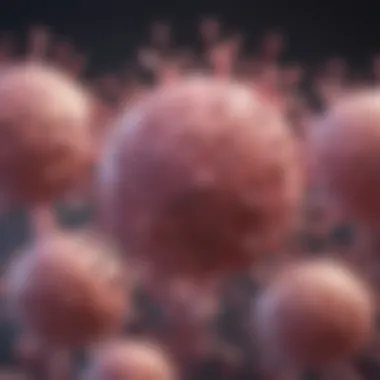Understanding Triple Negative Breast Cancer Treatment


Intro
Triple negative breast cancer (TNBC) represents a unique and challenging subset of breast cancer that is defined by the lack of three key receptors: estrogen, progesterone, and HER2. This absence significantly complicates treatment options, as many therapies that target these receptors are ineffective. Understanding the intricacies involved in the management of TNBC is paramount for patients, researchers, and healthcare professionals alike.
In recent years, research has illuminated many aspects surrounding TNBC, such as its biological underpinnings, potential treatment pathways, and the ongoing clinical trials aimed at improving patient outcomes. The urgency in advancing our understanding is evident, given that TNBC tends to be more aggressive and is associated with poorer prognosis compared to other breast cancer subtypes. By systematically examining both current practices and emerging innovations in treatment, we can gain insights that are essential in navigating this formidable diagnosis.
Research Overview
Key Findings
Research has shown that TNBC accounts for approximately 10-15% of all breast cancer cases. Due to its aggressive nature, it often presents at a more advanced stage than other types of breast cancer. Several recent studies indicate that immunotherapy, targeting the PD-1/PD-L1 pathway, is showing promising results in the treatment of this subtype. Combination therapies, including chemotherapy and immunotherapy, are currently under investigation and display potential for better outcomes.
Study Methodology
To understand the current trends and treatment avenues, a comprehensive review of the latest clinical trials and peer-reviewed articles was conducted. This involved analyzing data from major medical journals, relevant clinical trial registries, and integral cancer databases to aggregate insights into TNBC treatments. Interviews with oncologists and researchers familiar with this field added qualitative depth to the findings, highlighting both successes and ongoing challenges faced in TNBC management.
Background and Context
Historical Background
The initial characterization of TNBC occurred in the early 2000s. Before this, breast cancer treatments were primarily centered on hormone receptor-positive cases. The absence of targeted therapies for TNBC underscored a significant gap in oncology, steering research efforts towards understanding its specific molecular biology. Over the years, pivotal studies have gradually unveiled the distinct genetic and epigenetic features of TNBC, which has helped in reshaping the therapeutic landscape.
Current Trends in the Field
In recent years, there has been a paradigm shift towards personalized medicine and biomarker analysis in cancer therapy. Current trends indicate that testing for mutations, such as BRCA1 and BRCA2, has become central in developing targeted treatments. Notably, PARP inhibitors like Olaparib have emerged as treatment options in patients with specific genetic profiles. Furthermore, ongoing trials are exploring the efficacy of integrating novel agents, including antibody-drug conjugates, into standard care for TNBC.
As researchers and medical professionals delve deeper into the unique characteristics and treatment responses of TNBC, there remains a strong emphasis on collaborative efforts aimed at improving patient outcomes. Both clinical and laboratory research play vital roles in deciphering the complexities of this aggressive cancer. By synthesizing knowledge across disciplines, we can foster a more robust understanding of treatment options and pave the way for future innovations.
Prologue to Triple Negative Breast Cancer
Triple negative breast cancer (TNBC) represents a particularly challenging subtype of breast cancer. Understanding TNBC is crucial due to its distinct biological behavior and the unique treatment challenges it presents. Unlike other breast cancer types, which may express hormonal receptors, TNBC lacks the estrogen receptor, progesterone receptor, and human epidermal growth factor receptor 2 (HER2). This absence significantly influences treatment choices and outcomes.
The increasing prevalence of TNBC highlights the necessity for deeper insights into its treatment paradigms. Current research on the subject evaluates both established treatment protocols and emerging therapies. This article aims to dissect the complexities involved in managing TNBC, shedding light on ongoing developments that may improve care for patients.
Defining Triple Negative Breast Cancer
Triple negative breast cancer is characterized by the absence of three key receptors: estrogen, progesterone, and HER2. This distinct profile dictates the cancer's ability to respond to hormone therapies and targeted treatments, which are pivotal in other breast cancer types. TNBC often presents as a more aggressive form of the disease, with a higher likelihood of metastasis and recurrence within the first few years post-diagnosis.
In the clinic, TNBC cases are typically diagnosed through histopathological analyses and molecular profiling. Patients generally show a higher incidence in younger women and those of African ancestry. The complexity of diagnosing and categorizing TNBC underlines the need for a well-rounded understanding of its biological features to enable effective treatment pathways.
Epidemiology and Risk Factors
Epidemiological data indicates that TNBC accounts for about 10-20% of all breast cancer cases. Its occurrence is notably higher among specific demographics, such as African American women and those with BRCA1 mutations. Various risk factors contribute to the development of TNBC, some of which are well-established while others remain under investigation.
Common risk factors for TNBC include:
- Genetic predisposition: Mutations in BRCA1 and, less frequently, BRCA2 are significant contributors.
- Age: Younger age at diagnosis often correlates with TNBC.
- Ethnicity: Higher rates in African American and Hispanic populations.
Furthermore, lifestyle factors such as obesity and lack of physical activity, combined with environmental exposures, have also been implicated in the development of this aggressive cancer subtype. Understanding these factors is vital for devising strategies for prevention and early intervention in at-risk populations.


Biological Characteristics of Triple Negative Breast Cancer
The biological characteristics of triple negative breast cancer (TNBC) are vital for understanding its treatment and management. This subtype of breast cancer does not express the estrogen receptor, progesterone receptor, or human epidermal growth factor receptor 2. Thus, conventional endocrinological therapies typically used for other breast cancer types are ineffective in TNBC treatment. Given its unique biology, TNBC demonstrates distinct molecular pathways and tumor behaviors that are essential for developing targeted therapies.
Molecular Pathways Involved
The molecular pathways in TNBC distinctly contribute to its aggressiveness and treatment challenges. Notably, several key signaling pathways, including PI3K/Akt, MAPK, and p53, play prominent roles in tumor progression.
- PI3K/Akt Pathway: This pathway aids in cell growth, survival, and proliferation. Dysregulation often results in enhanced malignancy, promoting resistance to therapies.
- MAPK Pathway: During tumorigenesis, it facilitates cellular responses to various external stimuli, including stress and growth factors. Abnormal activity can lead to increased cell division and survival.
- p53 Tumor Suppressor: Changes in p53 function can result in loss of cell cycle control and resistance to apoptosis, further complicating TNBC management.
Understanding these molecular pathways is critical. They help researchers identify potential targets for innovative therapies and explore combination treatments that may overcome existing resistance mechanisms.
Genetic Mutations and Alterations
Genetic mutations in TNBC significantly impact the disease's biology and response to treatment. Several crucial genetic alterations have been identified in this subtype:
- BRCA1 and BRCA2 Mutations: These genes play essential roles in DNA repair. Mutations are often associated with TNBC and indicate a hereditary predisposition, impacting treatment decisions.
- TP53 Alterations: Mutations in the TP53 gene are common in TNBC and contribute to tumor aggressiveness.
- PIK3CA mutations: These mutations can activate the PI3K/Akt pathway, leading to resistance against traditional chemotherapy.
The identification of these genetic markers is pivotal for tailoring more personalized treatment strategies, such as PARP inhibitors, which exploit DNA repair deficiencies in tumors with BRCA mutations.
Tumor Microenvironment
The tumor microenvironment (TME) in TNBC plays a vital role in its development and progression. Various components make up the TME, including immune cells, extracellular matrix, and signaling molecules.
- Immune Cells: TNBC often exhibits a higher density of immune cells, particularly T lymphocytes. This immune infiltration suggests that the tumor may be more susceptible to immunotherapies. However, the immune response might not be sufficient to control growth without additional therapeutic intervention.
- Extracellular Matrix: The TME is characterized by alterations in the extracellular matrix, which can affect tumor growth and metastasis. A dense extracellular matrix can promote tumor cell invasion.
- Cytokines and Growth Factors: These factors contribute to communication between tumor cells and their microenvironment, influencing tumor behavior and treatment responses.
Understanding the TME facilitates better insights into TNBC behavior and resistance mechanisms. Approaches targeting TME components may enhance therapeutic efficacy and improve patient outcomes.
"The biological characteristics of triple negative breast cancer provide critical insights for developing effective treatment strategies that align with the unique features of this aggressive form of the disease."
In summary, the biological characteristics of triple negative breast cancer encompass a range of molecular pathways, genetic mutations, and the tumor microenvironment. By unraveling these aspects, researchers and clinicians can advance treatment protocols and devise innovative therapeutic strategies that cater specifically to TNBC's unique challenges.
Current Treatment Paradigms
Understanding the treatment paradigms for triple negative breast cancer (TNBC) is essential for both healthcare professionals and patients. This subtype of breast cancer presents unique challenges due to its aggressive nature and lack of targeted therapies. Patients with TNBC often face a poorer prognosis compared to other subtypes, making effective treatment strategies crucial.
In this section, we will delve into various treatment modalities available to patients, focusing on surgical interventions, chemotherapy options, and radiation therapy. Each of these approaches plays a significant role in managing TNBC, and their effectiveness can significantly influence patient outcomes.
Surgical Interventions
Surgical intervention remains a cornerstone in the treatment of triple negative breast cancer. It encompasses various types of surgeries, including lumpectomy and mastectomy. Lumpectomy involves removing the tumor along with a small margin of surrounding tissue, which allows for breast conservation. Contrastingly, mastectomy is the removal of one or both breasts and may be recommended in more advanced cases or for patients at high risk of recurrence.
The decision on which type of surgery to perform depends on several factors:
- Tumor size and location
- Patient's overall health
- Personal preferences regarding breast reconstruction
Post-operative considerations are also critical. Patients may need further treatments, such as chemotherapy or radiation, based on the tumor's characteristics. Surgical techniques have evolved, leading to improved cosmetic outcomes and reduced recovery times.
Chemotherapy Options
Chemotherapy is a fundamental component of TNBC management. Given the aggressive nature of the disease, systemic treatment can help manage disease progression and reduce the risk of metastasis. Regimens typically include anthracycline-based drugs like doxorubicin and taxanes such as paclitaxel.


Recent studies have introduced neoadjuvant chemotherapy, which is administered before surgery. This approach aims to shrink tumors, making them more operable. Patients often respond positively to neoadjuvant therapy, which may lead to higher rates of breast-conserving surgery and better overall outcomes.
Chemotherapy has its challenges, including:
- Side effects such as nausea, fatigue, and hair loss
- Consideration of timing and scheduling of treatments
- Monitoring for potential treatment resistance
Clinicians must tailor chemotherapy regimens based on each patient's specific circumstances, balancing effectiveness with potential toxicity.
Radiation Therapy
Radiation therapy plays a vital role in managing triple negative breast cancer, particularly following surgery. This treatment aims to eliminate residual cancer cells, thereby reducing the risk of local recurrence.
Radiation is often recommended after breast-conserving surgery and may also be applied after mastectomy based on specific factors, such as:
- Tumor size
- Lymph node involvement
- Margins of excision
The radiation treatment plan can vary but usually involves daily sessions over a span of several weeks. Advanced techniques like intensity-modulated radiation therapy (IMRT) provide precise targeting of cancer cells while sparing surrounding healthy tissue.
However, patients may experience side effects, including skin irritation and fatigue during the course of treatment. Close monitoring and communication between oncologists and patients are crucial to managing these potential issues effectively.
In summary, current treatment paradigms for triple negative breast cancer are multifaceted, incorporating surgical, chemotherapy, and radiation therapy options. Understanding these modalities empowers patients and their families to make informed decisions, which is vital for optimizing treatment and improving outcomes.
Emerging Therapeutic Strategies
The emergence of new therapeutic strategies marks a significant advancement in the treatment of triple negative breast cancer (TNBC). These strategies hold promise for improving survival rates and enhancing patient outcomes. Given the aggressive nature of TNBC and its tendency to develop resistance to traditional therapies, exploring innovative treatment options becomes paramount. This section delves into cutting-edge approaches, emphasizing their potential benefits, underlying mechanisms, and clinical implications.
Immunotherapy Approaches
Immunotherapy has surfaced as a groundbreaking strategy in the management of TNBC. This treatment harnesses the body’s immune system to identify and destroy cancer cells. Key agents in this category include immune checkpoint inhibitors, such as pembrolizumab and atezolizumab. These drugs target specific proteins that prevent the immune system from attacking the tumor.
The application of immunotherapy in TNBC has shown encouraging results, especially in patients with PD-L1 positive tumors. Clinical trials indicate that combining these agents with chemotherapy can lead to improved response rates. However, challenges remain, such as identifying the right patient populations and managing immune-related side effects. Therefore, ongoing research seeks to refine patient selection and develop biomarkers that predict treatment response.
Targeted Therapy Developments
Targeted therapies have revolutionized cancer treatment by focusing on specific molecular changes in tumors. In the context of TNBC, research has identified several promising targets, including the androgen receptor and the fibroblast growth factor receptor. By using drugs tailored to these targets, treatment can become more effective and potentially less toxic.
For instance, compounds such as enzalutamide have shown effectiveness in tumors expressing the androgen receptor. Additionally, new agents are under investigation that aim to inhibit pathological signaling pathways unique to TNBC. These developments underscore the importance of personalized medicine in enhancing therapeutic efficacy and mitigating adverse effects.
Clinical Trials and Their Importance
Clinical trials play a critical role in the advancement of TNBC treatment. They facilitate the evaluation of new therapies and their comparison to existing treatment protocols. Participation in clinical trials provides patients access to cutting-edge therapies that are not yet widely available.
Moreover, clinical trials help to gather data regarding efficacy, safety, and optimal dosing regimens. Insights gleaned from these studies may lead to a better understanding of the biology of TNBC and inform the development of future treatments. To facilitate patient enrollment, investigators must ensure that trials are accessible and that patients receive comprehensive information about their potential benefits and risks.
"Clinical trials are not just a pathway to new treatments; they are a vital component of our understanding of cancer biology."
The exploration of emerging therapeutic strategies in TNBC offers hope for better management and treatment outcomes. As research progresses, these innovations may ultimately lead to more effective, individualized treatment approaches for patients battling this challenging subtype of breast cancer.
Challenges in Treatment
Triple negative breast cancer (TNBC) presents unique challenges in patient management and treatment. This particular subtype lacks estrogen, progesterone, and HER2 receptors, making it resistant to common therapies that target these receptors. The absence of targeted treatment options complicates the therapeutic landscape and increases the urgency for innovative strategies. In this section, we will explore two primary challenges: treatment resistance mechanisms and patient-specific considerations.


Treatment Resistance Mechanisms
Understanding treatment resistance in triple negative breast cancer is crucial for developing effective therapies. Resistance often arises from several interconnected mechanisms:
- Genetic Mutations: Certain genetic alterations can render cancer cells impervious to conventional chemotherapeutic agents. For instance, mutations in the TP53 gene have been linked to poorer responses to treatments.
- Tumor Heterogeneity: TNBC is known for its biological diversity. This variability means that within a single tumor, some cells may respond well to treatment while others do not, complicating individualized treatment plans.
- Microenvironment Influence: The tumor microenvironment can also play a significant role in resistance. Factors such as tumor-associated macrophages and extracellular matrix components can promote survival pathways in cancer cells, making them less responsive to therapy.
"The complexity of TNBC demands a multifaceted approach to understand and mitigate treatment resistance factors."
Efforts to address these mechanisms are ongoing, but significant hurdles remain. Development of biomarkers that accurately predict resistance patterns is an area of active research. Moreover, new preclinical models may help in screening potential combination therapies aimed at overcoming resistance.
Patient-Specific Considerations
Patient-specific factors greatly influence treatment choice and effectiveness in triple negative breast cancer. As healthcare practitioners seek to personalize treatments, the following considerations are paramount:
- Age and Health Status: The patient’s overall health and comorbid conditions can dictate the type of therapy utilized, as certain treatments may be unsuitable for older adults or those with significant health challenges.
- Tumor Characteristics: Details such as tumor size, grade, and lymph node involvement can provide insights into prognosis and guide treatment decisions. For example, high-grade tumors may necessitate more aggressive treatment strategies.
- Psychosocial Factors: A patient’s mental and emotional health can affect treatment adherence. Support systems, patient education, and counseling should be integral parts of the treatment process.
- Genetic Testing: Knowledge of inherited mutations (such as BRCA1 or BRCA2) informs treatment decisions. Some patients may benefit from targeted therapies that are not routinely used in TNBC, such as PARP inhibitors.
Addressing the unique challenges associated with triple negative breast cancer requires a comprehensive understanding of both biological and individual patient factors. This dual focus can pave the way for paving the path towards improved treatment outcomes and quality of life for patients.
Future Directions in Research
Research in triple negative breast cancer (TNBC) is critical due to the unique challenges presented by this aggressive subtype. Despite advances in treatment, TNBC is associated with poor prognosis and limited options. Future directions aim to uncover new data that can lead to more effective and personalized treatment strategies. Focusing on this area can help bridge the gap in understanding the biology of TNBC, thereby improving patient outcomes.
Identifying Biomarkers
Biomarkers play a crucial role in the diagnosis and treatment of TNBC. Understanding these markers can significantly enhance treatment precision. Current treatment options are often generalized, but identifying specific biomarkers may tailor therapies to individual patients. This approach could lead to better therapeutic responses and reduced side effects.
Several biomarkers are currently being researched. For instance, the presence of PD-L1 can influence immunotherapy decisions. Other potential markers are still under investigation, including specific genetic alterations that could indicate susceptibility to certain treatments. Ultimately, a patient-centric approach that utilizes biomarker profiling can help clinicians select the most appropriate interventions.
“The future of TNBC treatment lies in personalized medicine—understanding how unique biological markers can inform treatment decisions will be pivotal.”
Integrative Approaches
Integrative approaches combining various therapeutic modalities represent a promising future direction in treating TNBC. These methods involve combining traditional treatments like chemotherapy with novel agents, including immunotherapies and targeted therapies. Combining different treatment paradigms may enhance efficacy while possibly decreasing the risk of resistance.
For instance, studies are evaluating the sequential use of chemotherapy followed by immunotherapy. This strategy may allow for a robust immune response post-chemotherapy, potentially leading to better disease control. Furthermore, integrating psychosocial support with medical treatment can improve patient adherence and quality of life, ultimately affecting clinical outcomes.
In summary, focusing time and resources on both identifying biomarkers and implementing integrative approaches is key for advancing the understanding and treatment of triple negative breast cancer. These initiatives can unlock new avenues for targeted therapies and enhance the overall management strategy, addressing the pressing needs of patients suffering from this complex disease.
Culmination
The conclusion serves as a vital component of this article, synthesizing the crucial insights and reflections drawn from the exploration of triple negative breast cancer treatment. It underscores the complex interplay of available therapies, ongoing research, and patient-centered considerations that define the current landscape of this challenging disease.
Summary of Key Points
This article has covered several essential points regarding the treatment of triple negative breast cancer:
- Defining characteristics: Understanding the nature of triple negative breast cancer is foundational as it lacks three critical hormone receptors, broadly impacting treatment options.
- Current standard therapies: The discussion of surgical, chemotherapy, and radiation therapy provides context for what is commonly employed in clinical settings.
- Innovative approaches: Emerging therapeutic strategies, particularly in immunotherapy and targeted treatments, offer new hope for patients. Clinical trials represent a significant frontier in testing and validating these treatments.
- Challenges faced: Notably, the hurdles of treatment resistance and unique patient considerations complicate management strategies, pointing to the necessity for individualized treatment plans.
- Future research directions: Identifying biomarkers and integrating various therapeutic approaches may lead to enhanced treatment outcomes and overall patient care.
In sum, this comprehensive examination emphasizes the current state and potential advancements in treating triple negative breast cancer, highlighting both the obstacles and the promising research avenues.
The Road Ahead
Looking forward, the future of triple negative breast cancer treatment must embrace a multi-faceted approach. Researchers and clinicians are urged to:
- Focus on personalized medicine: Better understanding genetic mutations and tumor biology will assist in tailoring treatment plans to individual patient needs and enhance effectiveness.
- Invest in clinical trials: Participation in ongoing research is crucial. Clinical trials not only advance therapeutic options but also provide patients access to cutting-edge treatments.
- Enhance collaboration: Interdisciplinary collaboration among oncologists, researchers, and patient advocates is needed to streamline care and foster innovative solutions.
- Educate patients: Providing comprehensive information about treatment options and emerging strategies enables patients to make informed choices about their care.
As research progresses, the ultimate goal remains clear: to improve outcomes and quality of life for individuals diagnosed with triple negative breast cancer. The continual evolution of treatment methodologies, coupled with dedicated research efforts, holds promise for a brighter future in combating this aggressive disease.







